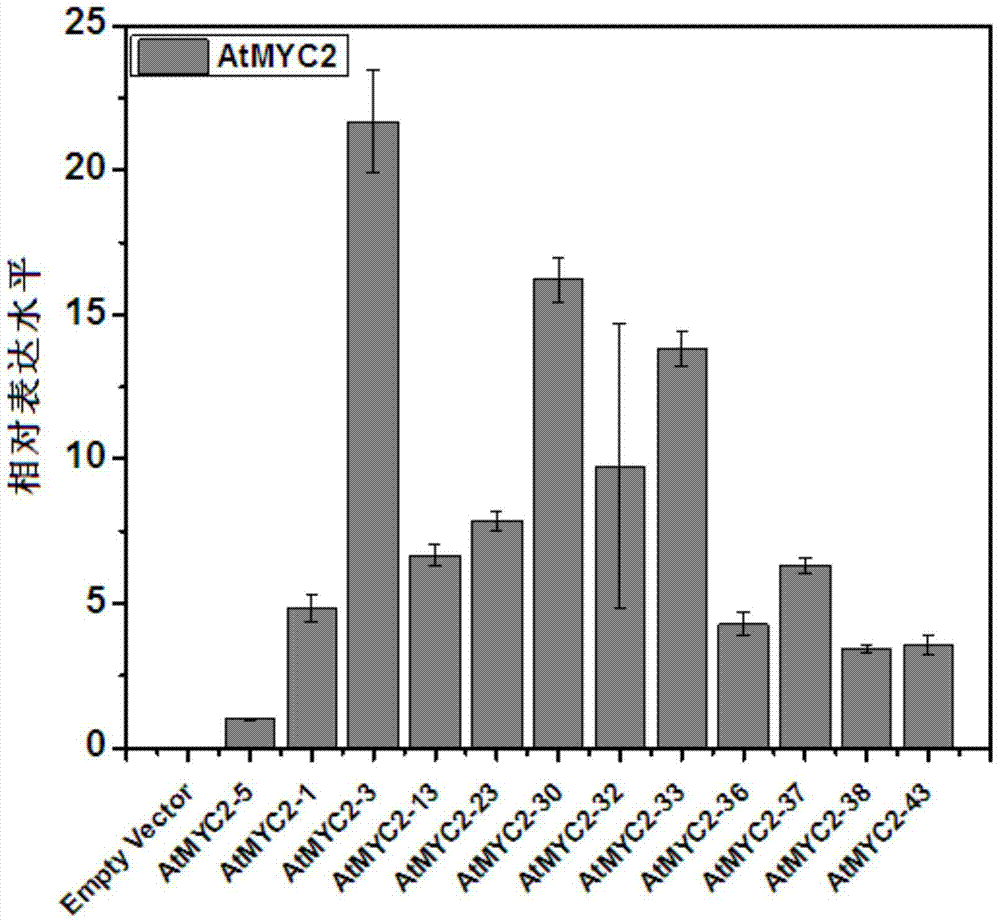Method for increasing contents of tanshinone and salvianolic acid in salvia miltiorrhiza hairy root by using transgene AtMYC2
A technology of hairy root and tanshinone, which is applied in the field of genetic engineering, can solve problems such as undiscovered hairy root tanshinone of Salvia miltiorrhiza, and achieve the effects of low cost, increased content, and reliable effect
- Summary
- Abstract
- Description
- Claims
- Application Information
AI Technical Summary
Problems solved by technology
Method used
Image
Examples
Embodiment 1
[0054] Cloning of Arabidopsis AtMYC2 Gene
[0055] 1.1. Extraction of Arabidopsis total RNA
[0056] Take a small amount of young leaves of Arabidopsis thaliana, quick-freeze them with liquid nitrogen, and quickly grind them with a mortar, and then extract total RNA according to the instructions of the RNAprep Pure Plant Kit provided by TIANGEN. The integrity of the RNA was detected by ordinary agarose gel electrophoresis (electrophoresis conditions: gel concentration 1.2%; 0.5×TBE electrophoresis buffer; 150v, 15min). The purity and concentration were detected with a Nano Drop 2000c ultra-micro spectrophotometer.
[0057] 1.2. Cloning of Arabidopsis AtMYC2 gene
[0058] Using 0.5 μg of total RNA from Arabidopsis thaliana as the initial amount, reverse transcriptase XL (AMV) was used to synthesize the first-strand cDNA (for the operation steps, refer to the relevant instructions provided by Promega). According to the coding sequence (SEQ ID NO.1) of described AtMYC2 gene, d...
Embodiment 2
[0060] Construction of Plant Overexpression Vector Containing Arabidopsis AtMYC2 Gene
[0061] For the carrier construction model diagram, see figure 1 . pCAMBIA2300 + As an intermediate expression vector, replace pCAMBIA2300 with the AtMYC2 gene cloned from Arabidopsis + on the gus gene. Specifically, Spe I / BstPI double enzyme cut pMD18-T::AtMYC2 and pCAMBIA2300 + ; Recover AtMYC2 gene and pCAMBIA2300 + Large fragments; ligation transformation, picking single clone colony PCR screening positive clones; extracting plasmid for further enzyme digestion verification. The results show that the AtMYC2 gene has been successfully constructed into the plant expression vector pCAMBIA2300 + In order to obtain the plant overexpression vector pCAMBIA2300 containing the AtMYC2 gene + ::AtMYC2.
[0062] In this example, the transcription factor AtMYC2 is operably linked to the expression control sequence to form the plant overexpression vector pCAMBIA2300 containing the AtMYC2 gene ...
Embodiment 3
[0065] Agrobacterium rhizogenes-mediated genetic transformation of Arabidopsis thaliana AtMYC2 gene to obtain transgenic hairy roots of Salvia miltiorrhiza
[0066] 3.1. Acquisition of Agrobacterium rhizogenes Engineering Bacteria Containing Plant Expression Vectors
[0067] The plant overexpression vector pCAMBIA2300 containing AtMYC2 gene in embodiment 2 + ::AtMYC2 was transformed into Agrobacterium rhizogenes C58C1, and a single clone colony was picked for PCR verification. The results showed that the plant overexpression vector pCAMBIA2300 containing AtMYC2 gene + ::AtMYC2 has been successfully constructed into Agrobacterium rhizogenes C58C1.
[0068] 3.2. Agrobacterium rhizogenes mediated genetic transformation of Salvia miltiorrhiza with AtMYC2 gene
[0069] 3.2.1 Preculture of explants
[0070] Cut the healthy aseptic seedling leaves of Salvia miltiorrhiza (0.5cm 2 ), inoculated onto the pre-culture medium (1 / 2MS), and cultured in the dark at 25°C for 2 days.
[0...
PUM
 Login to View More
Login to View More Abstract
Description
Claims
Application Information
 Login to View More
Login to View More - R&D
- Intellectual Property
- Life Sciences
- Materials
- Tech Scout
- Unparalleled Data Quality
- Higher Quality Content
- 60% Fewer Hallucinations
Browse by: Latest US Patents, China's latest patents, Technical Efficacy Thesaurus, Application Domain, Technology Topic, Popular Technical Reports.
© 2025 PatSnap. All rights reserved.Legal|Privacy policy|Modern Slavery Act Transparency Statement|Sitemap|About US| Contact US: help@patsnap.com



